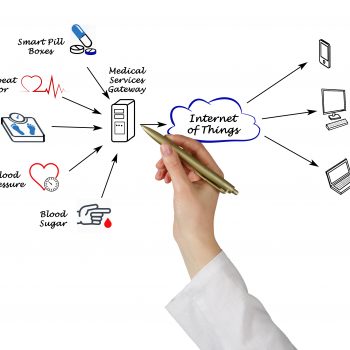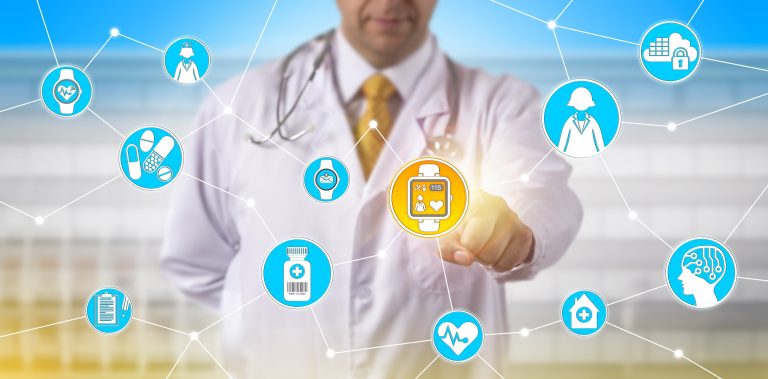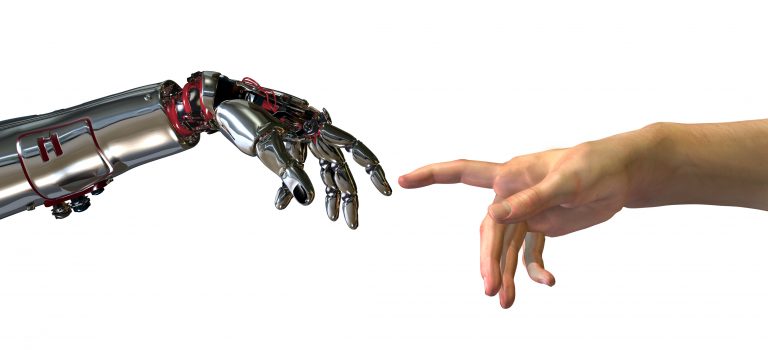What is Neurotechnology?
Neurotechnology is an emergent field with increasing impact on patient care. It can be defined as the use of technical tools enabling a direct connection between technical components and the nervous system. In other words, it refers to tools that (1) measure and analyze chemical and electrical signals and (2) interact with the nervous system. The aforementioned technical components include electrodes, computers, and neuroprostheses. Neurotechnology does not focus only on technology itself, but rather on utilizing that technology to gain insight into the human nervous system. In particular, it aims to understand the nervous processes involved in various diseases.
Different types of Neurotechnologies for Patient Care
Neurotechnologies function in one of two main ways. They can be broadly divided into recording devices and stimulators. The former involves recording brain signals and translating them into technical control commands. This may be used to study and diagnose pathological conditions, or to control external devices (e.g., neuroprostheses). Conversely, the latter involves manipulating brain activity through various types of stimuli. The devices used can be either invasive or noninvasive.
Deep Brain Stimulation (DBS)
DBS is a common type of “stimulator.” DBS electrodes are carefully inserted by a neurosurgeon into the relevant regions deep in the brain. Through interference with these targets, symptoms of specific brain diseases can be suppressed or reduced. That is, DBS applies weak electrical stimuli to activate or deactivate groups of cells or fibers within the brain. In turn, this helps alleviate symptoms caused by pathological nerve activity in that area.
Other Types of Electrical and Magnetic Brain Stimulations
Electrical and magnetic brain stimulations can influence brain activity via electrical impulses and magnetic fields, respectively. There are several types of electric brain stimulation. Among others, these include transcranial direct current stimulation (TDCS) and transcranial alternating current stimulation (TACS). TDCS is being used to improve performance and cognitive function. TACS may have implications for both improving memory and repairing brain damage. Indeed, there are some promising clinical trial results. However, the research is still in the early phase. Thus, these technologies are not yet ready for routine clinical use and should be used cautiously. Another promising type of stimulus is transcranial magnetic stimulation. This has shown some efficacy for treating depression.
Real-time Neuromonitoring
Systems actively monitoring brain activity and responding in real-time with appropriate actions are being developed. For example, these systems can detect symptoms suggesting an oncoming brain event (e.g., a seizure) and provide preemptive treatments to minimize or avoid the event. Some monitoring systems can be coupled with robotic aids to enable patients suffering from neurological disorders to regain lost motor control.
Big Data-enhanced Diagnostics and Treatments
In today’s digital world, brain health systems can leverage measurements from broader and broader populations. Analyzing these data can help understand exactly where an individual’s readings lie on the health-to-disease distribution curve. Using big data will also allow improved understanding of how an individual’s readings change over time. In turn, this will enable better diagnoses and treatments based on the treatment efficacies in other patients with similar brain signatures.
Brain-Computer Interfaces (BCIs)
BCIs acquire, analyze, and translate brain signals into commands. Subsequently, these commands are relayed to output devices that carry out the desired actions. The main goal of BCI technology is to improve function in people disabled by neuromuscular disorders.
Virtual-reality Treatments
Virtual-reality treatments are becoming increasingly used for several purposes. These include exposure therapy and post-traumatic stress disorder treatments. Further, virtual reality can be used for surgical planning and assisting surgeons in the operating room.
Wearables
Wearables, including commercially available ones such as Fitbit and Apple Watch, are being increasingly used to improve both physical and mental health. For example, activity and heart rate data can be collected and analyzed. Individualized training programs can be designed to improve physical health. Further, meditation and other mindfulness apps can be added to improve mental well-being.
Internet of Medical Things (IoMT)
The IoMT (also known as the “Healthcare IoT” or “Pharma IoT”) is a collection of medical devices and applications connected to IT systems through online networks. It was created as an effort to “move beyond the pill.” The IoMT involves digitalization of products and the related care processes using smart connected medical devices and IT services. This includes during all stages of therapy/drug development, clinical trials, and patient care. In brief, medical devices are equipped with Wi-Fi to allow machine-to-machine communication. These devices link to cloud platforms where the data are stored and analyzed.
 As part of patient care, the IoMT can help monitor and promptly notify caregivers and healthcare providers regarding potential issues. In turn, this allows for earlier intervention. An important utility of the IoMT includes remote monitoring of patients with chronic diseases. This is also known as “telemedicine” and saves patients from visiting a clinic or hospital every time they experience a change in condition. For example, IoMT solutions include wearable sensors for medication management in Parkinson’s disease or MS patients. Furthermore, tracking of medication adherence and the real-time location of patients are other current examples. Patients can also use IoMT devices and IoMT-connected smartphone apps to remind them about appointments and alert them about changes in blood pressure or glucose.
As part of patient care, the IoMT can help monitor and promptly notify caregivers and healthcare providers regarding potential issues. In turn, this allows for earlier intervention. An important utility of the IoMT includes remote monitoring of patients with chronic diseases. This is also known as “telemedicine” and saves patients from visiting a clinic or hospital every time they experience a change in condition. For example, IoMT solutions include wearable sensors for medication management in Parkinson’s disease or MS patients. Furthermore, tracking of medication adherence and the real-time location of patients are other current examples. Patients can also use IoMT devices and IoMT-connected smartphone apps to remind them about appointments and alert them about changes in blood pressure or glucose.
Finally, existing medical devices such as inhalers or insulin pumps can be added to the neurotechnologies used as part of the IoMT. This allows the collection of data for further analyses. Consequently, these patient care data provide new sources of innovation, facilitating the development of personalized therapy. However, there are also countless other potential applications in the neurotechnology space.
Current Applications of Neurotechnology for Patient Care
Currently, neurotechnology is used for multiple purposes. These include both assessments and interventions for various conditions. Presently used assessments include neuroimaging techniques such as functional magnetic resonance imaging (fMRI) and electroencephalography. Interventions include brain implants, BCI technologies, and electric/magnetic brain stimulations, among others. Some tools may play roles in both assessment and treatment. For example, real-time fMRI can be used to both image the neurobiology of a disease state and to provide neurofeedback-based rehabilitation.
BCI devices are used clinically to assist in the rehabilitation of patients with stroke, paralysis, and degenerative conditions. Moreover, DBS is regularly used in patients with Parkinson’s Disease in whom medication is ineffective. Other uses include symptom-relief in patients with epilepsy and Tourette Syndrome. Although DBS cannot cure neurodegenerative processes, it can alleviate severe symptoms such as tremor or rigor, thereby improving the patient’s quality of life. Neurotechnology can also be used to assess, treat, and study the complex socioemotional processes underlying various psychopathologies. Accordingly, DBS is also showing promise for the treatment of psychiatric disorders such as obsessive-compulsive disorder, depression, and addiction.
Future Applications
Neurotechnology is currently being assessed in several, albeit small, clinical trials. The potential uses of this technology are countless. Among others, using brain waves to control robotic limbs (i.e., neuroprostheses) is an emerging area of study. For obvious reasons, this application has many people very excited. Indeed, there are some promising results from small-scale clinical trials. The same type of implantable neurotechnologies also shows promise for the diagnosis of various neurological diseases, including epilepsy.
The role of BCIs in stroke rehabilitation is expected to increase in the future. This technology may also be used to augment the performance of surgeons or other medical professionals. Accordingly, BCI technology is a rapidly growing research area. Further, within the next 10 years, neurotechnologies will likely play a major role in the treatment of mental illnesses, complementing pharmacological and psychosocial therapies. In the mental health field, neurotechnologies may also help conduct evidence-based evaluations. This is especially important since effective assessment tools are still lacking for many disorders.
Current Barriers to Widespread Neurotechnology Use
Nevertheless, there are multiple challenges to overcome before neurotechnology will be routinely used clinically. Each specific technology faces its own barriers. For example, in terms of BCIs, several challenges exist. These include the need for signal-acquisition hardware that is convenient, portable, safe, and able to function in all environments. Second, real-world data validating the utility of BCI for the treatment and rehabilitation of stroke and other conditions must be collected and analyzed. Third, there need to be effective models for the widespread dissemination of BCIs. Lastly, the BCI performance and reliability must be further improved.
Furthermore, for the IoMT to reach its full potential, companies will need to determine how to turn all the collected data into insights and, eventually, actions. This will require administrators, manufacturers, and vendors to work together. Finally, although many IoMT-connected devices now have sensors for collecting data, they often communicate with the server in their own “language.” That is, as each manufacturer has their own proprietary protocol, sensors developed by different manufacturers or used at different centers cannot always communicate with each other. In turn, these barriers may undermine the whole IoT concept.
Ethical Issues
In addition to technological barriers, there are also several ethical issues to consider. With the increased use of IoMT technologies and collection of personal data, novel issues around data privacy and safety are likely to arise. In particular, pharmaceutical companies need to consider the recently implemented GDPR legislation when collecting patient data.
Ensuring secure data systems and neurotechnologies are of utmost importance. “Neurohacking” is one potential issue that must be dealt with before this technology becomes widespread. As an example, if connected to an IT system, a patient’s insulin pump could be hacked and the dose could be changed without the patient even being aware. In the future, neuroprostheses may contain wireless components that could be hacked, also resulting in potentially lethal outcomes.
Other ethical issues related to data security include how to handle an individual’s neurological information collected through these technologies. Should the authorities be informed if certain neural correlates of behavioral traits (for example, psychopathy, pedophilic arousal etc.) are discovered during neuroscans? If an individual is convicted of a certain crime, could or should they refer to their neuroscan results to claim innocence? How will these data be handled in criminal courts?
Finally, the potential for altered personality or ‘dehumanization’ is one of the major and most difficult challenges to address. There have been some cases of patients experiencing unfamiliar character traits or new behavioral patterns after invasive brain stimulation. While most such cases are subtle, they may also be quite severe. For example, there have been reports of rare cases of new-onset depressive disorder, disproportionate euphoria, or increased risk-taking behavior post-DBS. In the more distant future, the emerging neurotechnologies may also call into question the concept of what it means to be “human.” Will our perception of ourselves change when wired to, or even controlled by, machines?
Means to Overcome These Barriers
Whether technological or ethical in nature, it is clear that there are many obstacles to overcome before neurotechnology becomes part of standard patient care. More than anything, we need clear guidelines and regulations for every aspect of the process. In turn, this will require the cooperation of multiple stakeholders, as well as ongoing communication among all parties. Expert insights on how to best design, test, implement, market, and monitor neurotechnologies are invaluable for this purpose.
Fortunately, Impetus Digital can assist manufacturers with establishing a virtual advisory board platform, leveraging the expertise of select stakeholders. The online format is ideal for gathering timely and expert advice on how to best navigate the complicated processes surrounding neurotechnologies for patient care. The advisors can include physicians, allied healthcare providers, neurotechnology researchers, payers, and patients, among others. The enrolled advisors can be engaged through a series of online touchpoints either in the form of web meetings or online asynchronous assignments delivered as survey questions via InSite Surveyor™, discussion questions vs InSite Exchange™, or annotation exercises. Through these series of online touchpoints, manufacturers can solicit feedback on their regulatory, market access, medical, or marketing strategies.
The virtual nature of the boards and working groups can help increase the engagement rates of advisors, who are often extremely busy and utilized by multiple manufacturers for similar purposes. Moreover, the assignments, which are compelling, relevant, and timely, can give the advisors or steering committee members time to pause, reflect, process, and review their colleague’s comments on their own time. In turn, this allows for more thoughtful and granular insights shared through the online forums. Impetus creates, programs, project-manages, and reports all activities. Accordingly, the manufacturer’s workload is minimal and so are the costs when compared to more traditional in-person consultancy meetings.
References:
Chouffani, R. (2014). Can we expect the Internet of Things in healthcare? Retrieved from https://internetofthingsagenda.techtarget.com/feature/Can-we-expect-the-Internet-of-Things-in-healthcare
Dimitrov, D.V. (2016). Medical Internet of Things and Big Data in Healthcare. Healthcare Informatics Research, 22, 156-163.
Fernandez, A. (2015). 10 Neurotechnologies About to Transform Brain Enhancement and Brain Health. Retrieved from https://sharpbrains.com/blog/2015/11/10/10-neurotechnologies-about-to-transform-brain-enhancement-and-brain-health/
Geelen, J. (2012). The Emerging Neurotechnologies: Recent Developments and Policy Implications. Retrieved from http://www.horizons.gc.ca/en/content/emerging-neurotechnologies-recent-developments-and-policy-implications-0
Hogenboom, M. (2014). Warning over electrical brain stimulation. Retrieved from http://www.bbc.com/news/health-27343047
Marr, B. (2018). Why The Internet Of Medical Things (IoMT) Will Start To Transform Healthcare In 2018. Retrieved from: https://www.forbes.com/sites/bernardmarr/2018/01/25/why-the-internet-of-medical-things-iomt-will-start-to-transform-healthcare-in-2018/#6baedd574a3c
Mayo Clinic Staff. (2017). Transcranial magnetic stimulation. Retirieved from https://www.mayoclinic.org/tests-procedures/transcranial-magnetic-stimulation/about/pac-20384625
Müller, O., Rotter, S. (2017). Neurotechnology: Current Developments and Ethical Issues. Frontiers in Systems Neuroscience, 11, 93.
Rouse, M. (2015). IoMT (Internet of Medical Things) or healthcare IoT. Retrieved from https://internetofthingsagenda.techtarget.com/definition/IoMT-Internet-of-Medical-Things
Sandoiu, A. (2017). Electrical brain stimulation found to improve working memory. Retrieved from https://www.medicalnewstoday.com/articles/316370.php
Shih, J.J., Krusienski, D.J., Wolpaw, J.R. (2012). Brain-Computer Interfaces in Medicine. Mayo Clinic Proceedings, 87, 268-279.
University of Freiburg. (2018). Neurotechnology – Overview. Retrieved from http://www.neurotechnology.uni-freiburg.de/research/clinic/overview
White, S.W., Richey, J.A., Gracanin, J., Bell, M.A., LaConte, S., Coffman, M., Trubanova, A., Kim, I. (2015).The Promise of Neurotechnology in Clinical Translational Science. Clinical Psychological Science, 3, 797-815.



